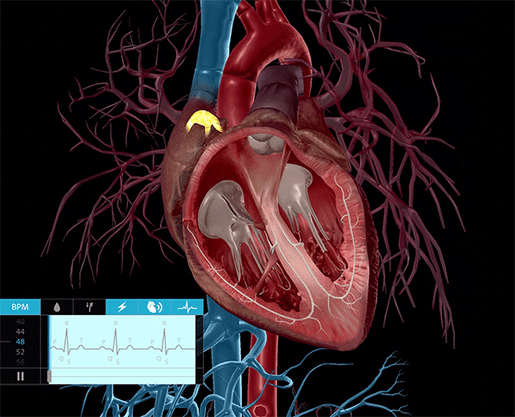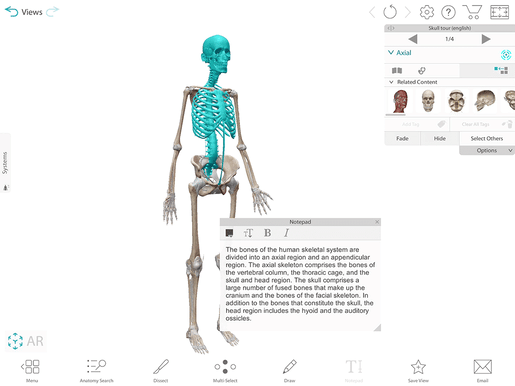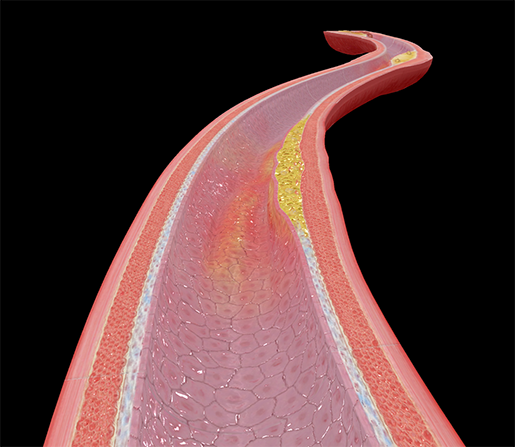4 Skills Health Sciences CTE Students Need to Be Workplace-Ready
Posted on 3/17/23 by Sarah Boudreau
When it comes to their careers, students in health sciences CTE programs want to hit the ground running. Likewise, schools want to produce students who will succeed in their new careers. Health field careers require a lot of technical skills and knowledge, but students also need “soft” skills to succeed.
If you’re a regular reader of the blog, then you already know why Visible Body is a great match for CTE programs. We’ve put together a list of five of the many skills CTE students need to be workplace-ready, along with links to resources and activities that will help instructors prepare students for the workforce!

Courseware allows you and your students to dissect a 3D beating heart!
1. Time Management
In a study that surveyed recent graduates in a variety of health professions, most respondents reported that they entered their careers with insufficient time and caseload management skills. These professionals believed that they needed more support as students to develop these skills.
Without proper time management skills, students entering the workforce will face an increase in stress and a decrease in productivity, which can ultimately lead to burnout and poor patient care.
One way to teach good time management skills is to encourage students to predict how long a task will take to complete. This will encourage reflection and planning as students form their estimations.
Time management is a crucial executive function skill. To read more, check out this blog post written by Jennifer Kravitz, part of the Visible Body customer engagement team: How Visible Body Supports Executive Function Skills.
2. Teamwork
In their future careers, students will need to collaborate with coworkers and supervisors—and when conflict arises, they need to know how to resolve it. Students in health fields will need to learn how to delegate or split up tasks over a group. They will also need to learn how to take feedback from supervisors and peers and develop an appreciation for the viewpoints and skills of other people on their team.
Not only do good teamwork skills prevent conflict, but they are also good for the patients: working in a team reduces errors.
Give your students a jump-start in building their teamwork skills by assigning group work in the classroom. By working together on an assignment, students will learn important social skills. Below are two lesson plans that incorporate group work—they also happen to involve augmented reality, which will engage students and get them learning in new and exciting ways.
- A Lesson Plan in AR: Five Interactive Muscle Actions in Augmented Reality
- Free AR Lesson Plan: The Anatomy and Physiology of the Eye
You can also learn more about team-based learning in this blog post, 4 Methods to Boost Student Engagement.
3. Communication
Clear communication is important in all careers, but it’s even more important in a fast-paced healthcare environment. Remember the survey discussed in the time management section? Many of the newly-graduated healthcare professionals emphasized that they needed to adapt their communication styles to different situations and environments.
In their future workplaces, students will need to communicate with patients, team members, and other coworkers—all of whom may be busy or stressed, making clarity and effectiveness even more crucial.
In a webinar for Visible Body, Dr. Cindy Harley explained how she shifted her classes away from traditional tests and towards assessments that ask students to develop their explanatory skills. She points out that in their future careers, students will need to explain concepts to patients, so it’s crucial that they get experience communicating complex health concepts while in school.
Learn about walkthrough videos and other forms of alternative assessment in this blog post: Make Life Sciences Classrooms More Inclusive by “Shaking Up” Assessment.

The Tours feature in Courseware allows you and your students to create interactive 3D presentations.
4. Critical thinking
In the workplace, not everything will be a textbook case. Students will need to think on their feet to solve problems and adapt to new situations—critical thinking demands more than just regurgitating information.
As an instructor, you can facilitate critical thinking through challenging your students to work through problems and find solutions.
 Explore pathologies like atherosclerosis in 3D with Courseware .
Explore pathologies like atherosclerosis in 3D with Courseware .
You can do this is through using case studies and other creative assignments. Try these blog posts for some inspiration:
- 5 Ways to Gamify Your A&P Classroom with Visible Body
- Reach More Students: Differentiated Instruction with Visible Body
Learn More
Visible Body products are used in schools around the world to develop the anatomy, physiology, and pathology knowledge students need for their future careers.
Interested in using Visible Body products in your CTE program? Check out what Richard Mantrana, lead instructor of the medical academy at Southwest Miami Senior High School, has to say about using Courseware in his classroom.
Be sure to subscribe to the Visible Body Blog for more awesomeness!
Are you an instructor? We have award-winning 3D products and resources for your anatomy and physiology or biology course! Learn more here.



